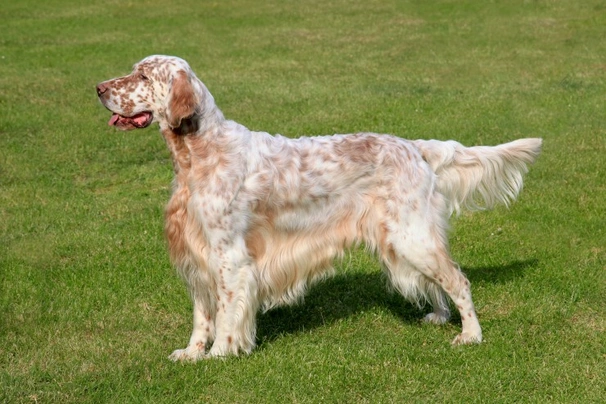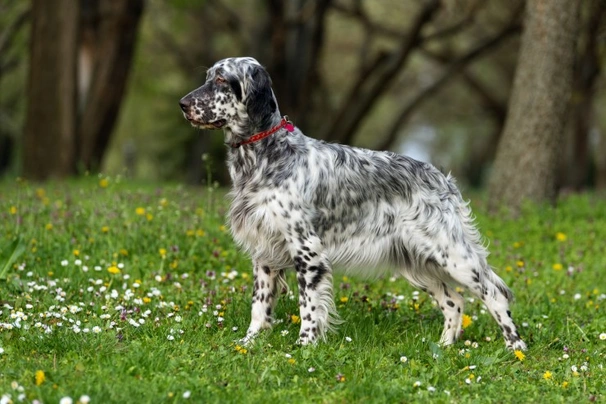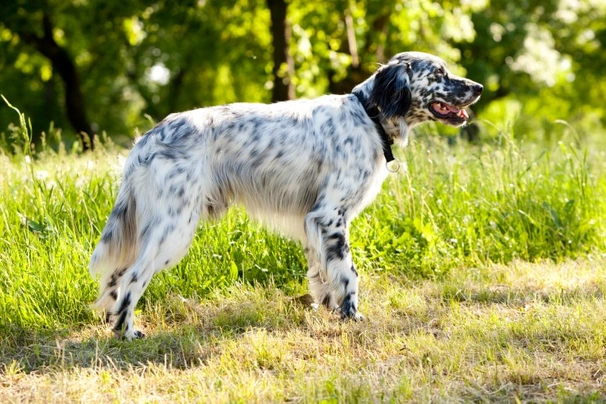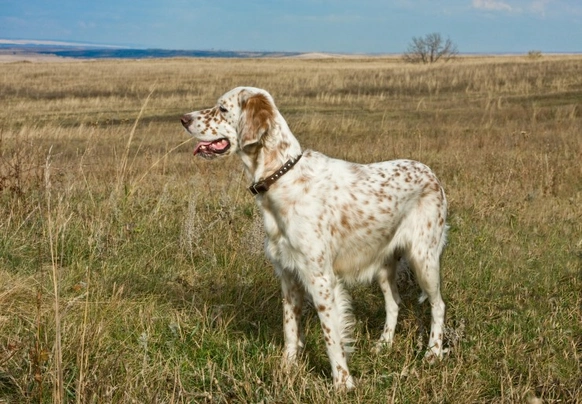English Setter
Pros
Cons
Introduction of the English Setter
English Setters remain one of the most popular choices with families and for good reason. These lovely elegant and stylish dogs boast kind gentle and placid natures making the ideal choice for first time owners and people with young families. The English Setter is also known to be a dog that attracts a lot of attention thanks to their good looks but it's their kind sweet and intelligent natures which makes them stand out in a crowd. In short English Setters are easy to train and become valued members of a household.
History of the English Setter
The English Setter is one of the oldest breeds of gundog in the world with records of these elegant dogs dating as far back as the 14th century. They were developed into the dogs we see today over hundreds of years and boast having various spaniels in their ancestry. They were original known as Setting Spaniels and were bred to work on rough challenging moorlands where they would track down wild fowl for the masters. Once a bird was found these spaniels would "set" remaining motionless while at the same time lifting a paw to indicate the location of the bird to the hunters. Once nets had been laid the dogs were then given the command to drive the birds into them which they did with great care and skill.
However the use of nets became outdated late in the 18th century when hunters started to use guns as a preferred method of hunting. As such these spaniels were no longer referred to as "Setting Spaniels" and became known as Setters instead. The first dogs of this type were owned by the upper classes and nobles of the day but there are no records of just where the spaniels first came from. With this said some people believe the dogs were bought to England from Europe or Asia when armies returned from wars they fought in various regions where these dogs originally came from.
It was not until the 19th century that the various Setters were classed as definite breeds in their own right although the aristocrats of the day often named their Setters using their family names. This led to various strains being created namely the Laverack Setters and the Llewellin Setters. Today these lovely looking and elegant dogs are still a firm favourite with families in the UK and elsewhere in the world all thanks to their kind placid and gentle natures.
Interesting facts about the breed
- Is the English Setter a vulnerable breed? No the breed was taken off the Kennel Club's list of vulnerable native breeds in 2012 and has fast become one of the more popular companions and family pets in the UK
- An English Setter won the Pointer and Setter Champion Stakes in 2016 that was held on the Byrecleug Estate on the Scottish Borders
- Most English Setters born and registered every year come from "show lines" which establishes their bloodlines rather than the fact they are excellent show dogs
- The breed was split into show and working lines many years ago with working lines now being quite rare
- English Setters from "working" lines need more in the way of mental stimulation and exercise having retained a strong hunting instinct and as such are not a good choice in a domestic environment
- A great place to trace the bloodlines of an English Setter is on World pedigrees.com
- The Animal Health Trust (AHT) is eager to receive reports of owners whose English Setters suffer from Seasonal Canine Illness
- Owners with deaf English Setters can find lots of information on Deaf Dogs Help
Appearance of the English Setter
Height at the withers: Males 65 - 69 cm Females 61 - 65 cm
Average weight: Males 25 - 36 kg Females 20 - 23 kg
The English Setter is an elegant glamorous dog that epitomises grace stamina and strength. They boast a very clean profile with working setters having a slightly lighter build. They carry heads high which adds to their elegant appearance and their heads are long and lean boasting a very definite stop. They have oval shaped skulls with moderately deep square muzzles. Their noses are either black or liver but this depends on the colour of a dog’s coat.
English Setters have bright and very expressive oval eyes that can be anything from hazel to a dark brown. However the darker their eyes are the better. The only time a lighter eye is acceptable is in liver beltons. Their ears are moderately long and set low on a dog's head and they hang neatly close to a dog's cheeks. The tips are velvety to the touch whereas the upper part is covered in silky fine hair.
Their mouths are strong with dogs boasting a perfect scissor bite where their upper teeth neatly overlap their lower ones. The English Setter has a long lean and muscular neck which dogs hold slightly arched. Their shoulders are well laid back or oblique and dogs have a deep chest with lots of width in between their shoulder blades. Front legs are long straight well-developed and extremely muscular.
Their body is moderately long with dogs boasting quite a short level back and well-rounded ribs. The English Setter has wide slightly arched loins and very muscular strong back legs with well-developed second thighs. Their feet are tight and nicely padded with arched toes protected by hair that grows in-between them. Their tail is set in line with their back and is moderately long which dog's carry curved showing off any feathering found on the underside of it. Their tails are thicker at the base but they taper towards the tip.
When it comes to their coat the English Setter boasts a slightly wavy one that's made up of silky long hair. They have breeches and their front legs are well feathered all the way down to a dog's feet. The accepted colours for Kennel Club registration are as follows:
- Black & White
- Black White & Tan
- Blue & White
- Blue Belton
- Blue Belton & Tan
- Lemon & White
- Lemon Belton
- Liver & White
- Liver Belton
- Liver White & Tan
- Orange & White
- Orange Belton
- Tricolour
Dogs should have flecked coats rather than heavy markings or patches which is more acceptable as a breed standard.
Gait/movement
When an English Setter moves they do so gracefully with a free-moving action which gives the impression of them having a good turn of speed and stamina. They move freely from the hock with a lot of drive in their hindquarters. When seen from behind their hips stifles and hock joints move in line with each other and dogs always have a high head carriage.
Faults
The Kennel Club frowns on any exaggerations or departures from the breed standard and would judge the faults on how much they affect a dog's overall health and wellbeing as well as their ability to perform.
Males should have both testicles fully descended into their scrotums and it is worth noting that a dog can be a little lighter or heavier as well as slightly taller or shorter than set out in the Kennel Club breed standard which is given as a guideline only.
Temperament of the English Setter
English Setters have a very keen look about them but they are extremely good natured and affectionate dogs. They are renowned for being placid and calm which is why they make such wonderful family pets. They tend to get on with everyone and everything which includes other pets and animals. They are a great choice for first time owners as long as they live in a house that boasts lots of space because English Setters are large dogs. Ideally owners need to have a secure garden for dogs to run around in which is where they can let off steam as often as possible.
However English Setters are high-energy dogs which means they need to be given lots of exercise and being such intelligent characters they also need to be given enough mental stimulation to prevent boredom setting in. They are the ideal choice for families that spend a of time at home and who like being in the great outdoors with an active canine companion at their side. They are also well suited to people who like taking part in canine sports like rally obedience and agility.
Are they a good choice for first time owners?
English Setters are a good choice for first time dog owners providing they have the time to dedicate to an intelligent active canine companion. They are especially good around children of all ages although playtime tends to be boisterous at times.
What about prey drive?
Well-bred English Setters are very social by nature but they have working and hunting dogs in their lineage which means they have a high prey drive and will happily chase any animal they spot in the distance that tries to run away. As such they need to be taught the recall command early in their lives and care should always be taken as to where and when an English Setter can run off the lead more especially when there is livestock or wildlife close by.
What about playfulness?
English Setters have a very playful side to their natures and love to entertain and be entertained. They are intelligent and love to play interactive games and love nothing more than to take part in all sorts of canine sports which includes agility and rally obedience which they excel at.
What about adaptability?
English Setters are much better suited to people who lead active outdoor lives and who have large secure back gardens a dog can safely roam in whenever possible. They are large dogs that need enough space to express themselves as such they are not a good choice for people who live in apartments.
What about separation anxiety?
Although English Setters form strong ties with their families they don't generally mind being left on their own providing it is never for too long. In short they are not known to suffer from separation anxiety when they are left to their own devices for a few hours but as previously mentioned never for too long.
What about excessive barking?
English Setters are not known to be "barkers" and will only usually voice an opinion when there are strangers about or when something they don't like is going on in their surroundings as a way of alerting an owner to what is going on.
Do English Setters like water?
Most English Setters like swimming and will take to the water whenever they can more especially when the weather is hot. However if anyone who owns a dog that does not like water should never force them to go in because it would just end up scaring them. With this said care should always be taken when walking an English Setter off the lead anywhere near more dangerous watercourses just in case a dog decides to leap in and then needs rescuing because they cannot get out of the water on their own. It is also essential for their tails and coats to be thoroughly dried off when a Setter gets wet to prevent them suffering from dead tail or hot spots.
Are English Setters good watchdogs?
English Setters are not natural watchdogs although this is not to say a dog would not be quick off the mark to let an owner know when there are strangers about although they would rarely do this aggressively preferring to keep their distance and bark as a way of alerting their owners.
Intelligence / Trainability of the English Setter
The English Setter is a very intelligent dog and therefore they respond well to the right sort of positive reinforcement training. However their education needs to start when dogs are still young to lay the ground rules down and to reduce the risk of a dog's natural instincts taking over which invariably sees these dogs running off to explore their environment whenever the mood takes them. It's a good idea to enrol a young dog into obedience classes as soon as they have been fully vaccinated which English Setters thoroughly enjoy. In the long run attending these classes the efforts can pay dividends with the result being a much more obedient dog.
English Setter puppies like all other puppies are incredibly cute and it is all too easy to spoil them when they first arrive in their new homes. However being so clever a setter puppy quickly learns new things and this includes the good and the bad. As such their education must start early so that puppies understand what is expected of them and what is acceptable behaviour and what is not. Boundaries and limits must be set with puppies being taught the following commands as soon as possible so they don't turn into unruly and wilful adult dogs:
- Come
- Sit
- Stay
- Heel
- Quiet
- Leave it
- Down
- Bed
Children and other
English Setters have an affinity with children of all ages but they form very strong bonds with everyone in a household. Their tolerance level is high when it comes to the kids which is just one of the reasons they have remained such a popular choice for people with young families here in the UK and elsewhere in the world.
English Setters also get on well with other animals and this includes the family cat providing they have been well socialised and introduced to them at a young age. They rarely show any sort of aggressive behaviour towards other pets or dogs they meet in the park either. However as with any other breed it pays to introduce new animals to them carefully to make sure things go smoothly.
Health of the English Setter
The average life expectancy of an English Setter is between 9 to 15 years when properly cared for and fed an appropriate good quality diet to suit their ages.
Like many other pure breeds they are known to suffer from a few breed-specific health issues which are worth knowing about if you are hoping to share your home with one of these elegant lively dogs. The health concerns that seem to affect the breed the most include the following:
- Hip dysplasia - DNA test available through the Kennel Club and dogs should be hip scored
- Congenital deafness - dogs can be BAER tested through the Animal Health Trust (AHT)
- Dead Tail
- Injuries to occiputs - more especially in puppies and younger English Setters
- Hot spots
- Seasonal canine illness
More about "dead tail"
Occasionally English Setters can suffer from a condition known as "dead tail" which is a painful disorder although it never seems to last for very long. The problem typically develops after a dog has been bathed although it can occur when they have been in water or even when they sit down on a cold day when it is raining.
As previously mentioned it is a painful condition that sees Setters not being able to lift their tails which remains paralysed without hanging limply. Dogs often try to wag their tails which causes them even more discomfort and distress. The result often sees dogs unable to move their backends and the condition can last for up to 1 or 2 days before a Setter recovers. Providing the condition does not last more than 2 days veterinary attention is not necessary but it is worth noting that many vets do not recognise "dead tail" as a serious condition that merits investigation.
More about injuries to occiputs
One of the English Setters defining features is the occipital bump found at the back of their skulls which gives their heads such a lovely unique shape. All too often puppies and young dogs bump their heads when they play fight which can result in internal bleeding and this can lead to them developing a large lump on their heads. The best way to deal with the problem is to place a bag of frozen peas on the swelling which helps reduce the inflammation with the downside being that it could cause further internal bleeding. In very severe cases veterinary attention is necessary.
What about vaccinations?
English Setter puppies would have been given their initial vaccinations before being sold but it is up to their new owners to make sure they have their follow-up shots in a timely manner with the vaccination schedule for puppies being as follows:
- 10 -12 weeks old bearing in mind that a puppy would not have full protection straight away but would be fully protected 2 weeks after they have had their second vaccination
There has been a lot of discussion about the need for dogs to have boosters. As such it's best to talk to a vet before making a final decision on whether a dog should continue to have annual vaccinations which are known as boosters.
What about spaying and neutering?
A lot of vets these days recommend waiting until dogs are slightly older before spaying and neutering them which means they are more mature before undergoing the procedures. As such they advise neutering males and spaying females when they are between the ages of 6 to 9 months old and sometimes even when a dog is 12 months old.
Other vets recommend spaying and neutering dogs when they are 6 months old but never any earlier unless for medical reasons. With this said many breeds are different and it is always advisable to discuss things with a vet and then follow their advice on when a dog should be spayed or neutered.
What about obesity problems?
Some English Setters gain weight after they have been spayed or neutered and it's important to keep an eye on a dog's waistline just in case they do. If a dog starts to put on weight it's important to adjust their daily calorie intake and to up the amount of exercise they are given. Older dogs too are more prone to gaining weight and again it's essential they be fed and exercised accordingly because obesity can shorten a dog's life by several years. The reason being that it puts a lot of extra strain on a dog's internal organs including the heart which could prove fatal.
What about allergies?
English Setters are prone to suffering from allergies and it's important for a dog to see a vet sooner rather than later if one flares up bearing in mind that the breed is known to suffer from "hot spots". Allergies can be notoriously hard to clear up and finding the triggers can be challenging. With this said a vet would be able to make a dog with an allergy more comfortable while they try to find out the triggers which could include the following:
- Certain dog foods that contain high levels of grain and other cereal fillers
- Airborne pollens
- Dust mites
- Environment
- Flea and tick bites
- Chemicals found in everyday household cleaning products
Participating in health schemes
All responsible English Setter breeders would ensure that their stud dogs are tested for known hereditary and congenital health issues known to affect the breed by using the following schemes:
- Hip dysplasia through the BVA/KC scheme
- Congenital deafness through the Animal Health Trust (AHT) - white coated dogs and dogs with a lot of white in their coats
What about breed specific breeding restrictions?
Apart from the breeding restrictions set out by the Kennel Club for all registered breeds there are no other breed specific breeding restrictions for the English Setter.
What about Assured Breeder Requirements?
It is mandatory for all Kennel Club Assured breeders to use the following scheme on stud dogs and the KC strongly recommends that all other breeders follow suit:
Caring for the English Setter
As with any other breed English Setters need to be groomed on a regular basis to make sure their coats and skin are kept in top condition. They also need to be given regular daily exercise to ensure they remain fit and healthy. On top of this they need to be fed good quality food that meets all their nutritional needs throughout their lives.
Caring for an English Setter puppy
English Setter puppies are boisterous and full of life which means it's essential for homes and gardens to be puppy-proofed well in advance of their arrival. A responsible breeder would have well socialised their puppies which always leads to more outgoing confident and friendly dogs right from the word go. With this said any puppy is going to feel vulnerable when they leave their mother and littermates which must be taken into account. The longer a puppy can remain with their mother the better although it should never be for too long either.
It's best to pick a puppy up when people are going to be around for the first week or so which is the time needed for a puppy to settle in. Puppy-proofing the home and garden means putting away any tools and other implements that a boisterous puppy might injure themselves on. Electric wires and cables must be put out of their reach because puppies love chewing on things. Toxic plants should be removed from flowerbeds and the home too.
Puppies need to sleep a lot to grow and develop as they should which means setting up a quiet area that's not too out of the way means they can retreat to it when they want to nap and it's important not to disturb them when they are sleeping. It's also a good idea to keep "playtime" nice and calm inside the house and to have a more active "playtime" outside in the garden which means puppies quickly learn to be less boisterous when they are inside.
The documentation a breeder provides for a puppy must have all the details of their worming date and the product used as well as the information relating to their microchip. It is essential for puppies to be wormed again keeping to a schedule which is as follows:
- Puppies should be wormed at 6 months old
- They need to be wormed again when they are 8 months old
- Puppies should be wormed when they are 10 months old
- They need to be wormed when they are 12 months old
Things you'll need for your puppy
There are certain items that new owners need to already have in the home prior to bringing a new puppy home. It's often a good idea to restrict how much space a puppy plays in more especially when you can't keep an eye on what they get up to bearing in mind that puppies are often quite boisterous which means investing in puppy gates or a large enough playpen that allows a puppy the room to express themselves while keeping them safe too. The items needed are therefore as follows:
- Good quality puppy or baby gates to fit on doors
- A good well-made playpen that's large enough for a puppy to play in so they can really express themselves as puppies like to do
- Lots of well-made toys which must include good quality chews suitable for puppies to gnaw on bearing in mind that a puppy will start teething anything from when they are 3 to 8 months old
- Good quality feed and water bowls which ideally should be ceramic rather than plastic or metal
- A grooming glove
- A slicker brush or soft bristle brush
- Dog specific toothpaste and a toothbrush
- Scissors with rounded ends
- Nail clippers
- Puppy shampoo and conditioner which must be specifically formulated for use on dogs
- A well-made dog collar or harness
- A couple of strong dog leads
- A well-made dog bed that's not too small or too big
- A well-made dog crate for use in the car and in the home that's large enough for a puppy to move around in
- Baby blankets to put in your puppy's crate and in their beds for when they want to nap or go to sleep at night
Keeping the noise down
All puppies are sensitive to noise including English Setter puppies bearing in mind that they are quite sensitive by nature to loud sounds and raised voices. It's important to keep the noise levels down when a new puppy arrives in the home. TVs and music should not be played too loud which could end up stressing a small puppy out.
Keeping vet appointments
As previously mentioned English Setter puppies would have been given their first vaccinations by the breeders but they must have their follow up shots which is up to their new owners to organise. The vaccination schedule for puppies is as follows:
- 10 -12 weeks old bearing in mind that a puppy would not have full protection straight away but would only be fully protected 2 weeks after they have had their second vaccination
When it comes to boosters it's best to discuss these with a vet because there is a lot of debate about whether a dog really needs them after a certain time. However if a dog ever needed to go into kennels their vaccinations would need to be fully up to date.
What about older English Setters when they reach their senior years?
Older English Setters need lots of special care because as they reach their golden years they are more at risk of developing certain health concerns. Physically a dog's muzzle may start to go grey but there will be other noticeable changes too which includes the following:
- Coats become coarser
- A loss of muscle tone
- Setters can either become overweight or underweight
- They have reduced strength and stamina
- Older dogs have difficulty regulating their body temperature
- They often develop arthritis
- Immune systems do not work as efficiently as they once did which means dogs are more susceptible to infections
Older dogs change mentally too which means their response time tends to be slower as such they develop the following:
- They respond less to external stimuli due to impaired vision or hearing
- They tend to be a little pickier about their food
- They have a lower pain threshold
- Become intolerant of any change
- Often an older dog can feel disorientated
Living with an English Setter in their golden years means taking on a few more responsibilities but these are easily managed and should include taking a look at their diet the amount of exercise they are given how often their dog beds need changing and keeping an eye on the condition of their teeth.
Older English Setters need to be fed a good quality diet that meets their needs at this stage of their lives all the while keeping a close eye on a dog's weight. A rough feeding guide for older dogs is as follows bearing in mind they should be fed highly digestible food that does not contain any additives:
- Protein content should be anything from 14 – 21%
- Fat content should be less than 10%
- Fibre content should be less than 4%
- Calcium content should be 0.5 – 0.8%
- Phosphorous content should be 0.4 – 0.7%
- Sodium content should be 0.2 – 0.4%
Older Setters don't need to be given the same amount of daily exercise as a younger dog but they still need the right amount of physical activity to maintain muscle tone and to prevent a dog from putting on too much weight. All dogs need access to fresh clean water and this is especially true of older dogs when they reach their golden years because they are more at risk of developing kidney disorders.
Grooming of the English Setter
English Setters are high maintenance in the grooming department all thanks to their long and silky fine coats. They need to be groomed on a regular basis to ensure no matts or tangles develop which can make brushing them that much harder. Dogs with very long feathers may need to go to a grooming parlour to have them trimmed to a more manageable length. It's also important to keep an eye on the feathers that grow in a dog's ears because these tend to get a bit dirty when dogs eat or drink.
English Setters have a lot of hair between their toes which needs to be kept clean and free of any mud or debris and the same can be said of between their paw pads. If too much wax builds up in these areas it can make life very uncomfortable for a dog. It's a good idea to check an English Setter's feet every time they come back from a walk especially if they have been running around in the park or through the countryside in wet or muddy conditions.
It also pays to take an English Setter to be professionally groomed at least 3 to 4 times a year which makes keeping their coats and skin in good condition that much easier in between visits to the parlour. Just like other dogs they tend to shed more during the Spring and then again in the Autumn when more frequent grooming would be needed to keep on top of things.
Exercise of the English Setter
English Setters are high-energy dogs and they need to be given the correct amount of exercise to be truly happy well-rounded characters. This means walking a dog for a minimum of 2 hours a day and ideally if they can run around a secure garden to let off steam as often as possible all the better. They are the perfect choice for people who lead active outdoor lives. They are not a good choice for people who lead more sedentary indoor lives. It is worth noting that the majority of English Setters remain active right through their lives and well into their senior years.
Feeding of the English Setter
If you get an English Setter puppy from a breeder they would give you a feeding schedule and it's important to stick to the same routine feeding the same puppy food to avoid any tummy upsets. You can change a puppy's diet but this needs to be done very gradually always making sure they don't develop any digestive upsets and if they do it's best to put them back on their original diet and to discuss things with the vet before attempting to change it again.
Older dogs are not known to be fussy or finicky eaters but this does not mean they can be feed a lower quality diet. It's best to feed a mature dog twice a day once in the morning and then again in the evening making sure it's good quality food that meets all their nutritional requirements. It's also important that dogs be given the right amount of exercise so they burn off any excess calories or they might gain too much weight which can lead to all sorts of health issues. Obesity can shorten a dog's life by several years so it's important to keep an eye on their waistline from the word go.
Feeding guide for an English Setter puppy
Puppies need to be fed a highly nutritious good quality diet for them to develop and grow as they should. As a rough guide an English Setter puppy can be fed the following amounts every day making sure their meals are evenly spread out throughout the day and it's best to feed them 3 or 4 times a day:
- 2 months old - 244g to 286g depending on puppy's build
- 3 months old - 307g to 365g depending on puppy's build
- 4 months old - 335g to 400g depending on puppy's build
- 5 months old - 361g to 454g depending on puppy's build
- 6 months old - 385g to 505g depending on puppy's build
- 7 months old - 383g to 506g depending on puppy's build
- 8 months old - 354g to 471g depending on puppy's build
- 9 months old - 329g to 440g depending on puppy's build
- 10 months old - 298g to 402g depending on puppy's build
- 11 months old - 270g to 365g depending on puppy's build
- 12 months old - 268g to 363g depending on puppy's build
- 13 months old - 266g to 369g depending on puppy's build
- 14 months old - 266g to 357g depending on puppy's build
Once a puppy is 15 months old they can be fed adult dog food.
Feeding guide for an adult English Setter
Once fully mature an adult dog must be fed a good quality diet to ensure their continued good health. As a rough guide an adult English Setter can be fed the following amounts every day:
- Dogs weighing 20 kg can be fed 256g to 343g depending on activity
- Dogs weighing 23 kg can be fed 246g to 333g depending on activity
- Dogs weighing 25 kg can be fed 276g to 363g depending on activity
- Dogs weighing 36 kg can be fed 352g to 463g depending on activity
English Setter price
If you are looking to buy an English Setter you would need to pay anything from £500 to over £1000 for a well-bred pedigree puppy.
The cost of insuring a male 3-year-old English Setter in northern England would be £23.17 a month for basic cover but for a lifetime policy this would set you back £49.55 a month (quote as of December 2017). When insurance companies calculate a pet's premium they factor in several things which includes where you live in the UK and a dog's age and whether they have been neutered or spayed.
When it comes to food costs you need to buy the best quality food whether wet or dry to feed your dog throughout their lives making sure it suits the different stages of their lives. This would set you back between £40 - £60 a month. On top of this you would need to factor in veterinary costs if you want to share your home with an English Setter and this includes their initial vaccinations their annual boosters the cost of neutering or spaying your dog when the time is right and their yearly health checks all of which quickly adds up to over a £1000 a year.
As a rough guide the average cost to keep and care for an English Setter would be between £80 to £120 a month depending on the level of insurance cover you opt to buy for your dog but this does not include the initial cost of buying a healthy well-bred Kennel Club registered pedigree puppy.
Buying advice
When visiting and buying any puppy or dog there are many important things to consider and questions to ask of the breeder/seller. You can read our generic puppy/dog advice here which includes making sure you see the puppy with its mother and to verify that the dog has been wormed and microchipped.
English Setters are no longer thought of as a vulnerable breed and are now finding their way into the hearts and homes of many people both in the UK and elsewhere in the world which means that well-bred healthy puppies can often command a lot of money. As such with English Setters there is specific advice questions and protocols to follow when buying a puppy which are as follows:
- Beware of online scams and how to avoid them. You may see online and other adverts by scammers showing images of beautiful English Setter puppies for sale at very low prices. However the sellers ask buyers for money up front before agreeing to deliver a puppy to a new home. Potential buyers should never buy a puppy unseen and should never pay a deposit or any other money online to a seller. You should always visit the pet at the sellers home to confirm they are genuine and make a note of their address.
- As previously touched upon English Setters have consistently remained a popular breed in the UK. As such there are many amateur breeders/people who breed from a dam far too often so they can make a quick profit without caring for the welfare of the puppies their dam or the breed in general. Under Kennel Club rules a dam can only produce 4 litters and she must be between a certain age to do so. Anyone wishing to buy an English Setter puppy should think very carefully about who they purchase their puppy from and should always ask to see the relevant paperwork pertaining to a puppy's lineage their vaccinations and their microchipping.
- Prospective owners should be very careful when considering buying an English Setter with a white coat or one that has a lot of white in it because of the health issue associated with the white gene namely congenital deafness. Prospective owners should ask breeders about parent dogs and their offspring to find out whether they have been BAER tested.








